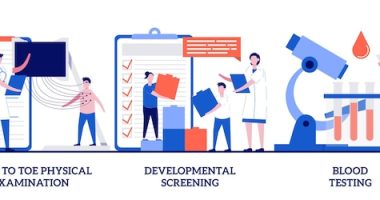In the realm of oncological treatments, the cost-effectiveness analysis for low-risk GTN (gestational trophoblastic neoplasia) is crucial for healthcare systems, particularly when comparing treatments like hysterectomy versus chemotherapy. This study, led by Cristina Mitric, Rashid K Sayyid, Neil E Fleshner, Nicole J Look Hong, and Genevieve Bouchard-Fortier, rigorously assesses these modalities using decision analysis and Markov modeling from the perspective of Canadian healthcare payers. Focused on a base case scenario of a 40-year-old patient diagnosed with low-risk non-metastatic GTN who has completed childbearing, the analysis ventures to determine a cost-effective strategy between single-agent chemotherapy and hysterectomy.
The key outcomes measured include life years (LYs), quality-adjusted life years (QALYs), and the incremental cost-effectiveness ratio (ICER), all adjusted to 2022 costs in CAD. The study implements a comprehensive validation process involving face validity along with deterministic sensitivity and scenario analyses to ensure robustness and relevancy of findings. A poignant result of the analysis showed mean costs of $34,507 for chemotherapy and $17,363 for hysterectomy, with QALYs sitting at 30.37 versus 30.14 respectively. Moreover, the ICER calculated was $74,526 per QALY, presenting a strong case for the continuation of chemotherapy as a standard of care due to its favorable cost-effectiveness under the typical willingness-to-pay thresholds in healthcare. This research underscores the financial and clinical considerations pivotal in determining the optimal approach for treating low-risk GTN.
The discussion of cost-effectiveness analysis for low-risk GTN (gestational trophoblastic neoplasia) emerges as a significant topic in the field of medical research and healthcare management. This analysis is particularly pertinent given the nature of GTN as a group of rare tumors derived from the trophoblastic tissue, which, while often curable, requires thoughtful intervention to optimize both outcomes and economic efficiency. The decision between pursuing surgical options such as hysterectomy versus pharmacological interventions like chemotherapy presents a multifaceted challenge. This challenge not only encompasses clinical outcomes but also integrates broader economic considerations, which are vital in a publicly funded healthcare system, such as that of Canada.
Low-risk GTN generally exhibits a high cure rate, and the treatment strategies aim to maintain the patient’s health while minimizing unnecessary medical interventions and associated costs. In instances where a patient has completed childbearing, as in the base case scenario of a 40-year-old patient assessed in this study, the choice of treatment modality acquires added dimensions of quality-of-life impacts and long-term economic implications.
Historically, the management of low-risk GTN has leaned towards conservative treatments, with chemotherapy being a preferred option due to its high efficacy and fertility-preserving nature. However, in cases where future fertility is not a concern, surgical options like hysterectomy present a viable alternative. This backdrop makes the cost-effectiveness analysis low-risk GTN especially critical as it guides healthcare providers and policymakers in optimizing resource allocation while maintaining excellent care quality.
The rigorous methodology adopted by Cristina Mitric et al., involving decision analysis and Markov models, reflects a structured approach to dissecting this complex decision landscape. By evaluating not just the direct costs but also the nuanced aspects of patient quality of life through QALYs and life years (LYs), the study achieves a holistic view of the implications of each treatment modality.
Thus, such cost-effectiveness analysis low-risk GTN is crucial not only in guiding individual patient care strategies but also in shaping health policy and payer decisions in oncology. It ensures that the treatments provided not only achieve the best possible outcomes for patients but also do so in a manner that is economically sustainable. The findings from this study, favoring chemotherapy as a more cost-effective treatment for the specified patient scenario, bolster the argument for nuanced, patient-specific treatment planning in low-risk GTN cases. Such research also sets a precedent for future studies aiming to refine and personalize therapeutic approaches in similar oncological contexts, potentially impacting a broader spectrum of treatment protocols and health system efficiencies.
The study by Cristina Mitric et al. on the cost-effectiveness analysis for low-risk GTN meticulously integrates decision analysis and Markov modeling to evaluate the economic and health outcomes of treatment alternatives, specifically chemotherapy and hysterectomy. This methodology plays a central role in guiding clinical and policy decisions, particularly under the economic constraints of the Canadian healthcare system. The research effectively compares the long-term effects and costs of both treatment modalities from the perspective of Canadian healthcare payers, focusing on a demographic with completed childbearing, thereby emphasizing the importance of cost-effectiveness analysis low-risk GTN.
**Markov Models**: In the study, Markov models were utilized to simulate the disease progression and recovery over time, offering a dynamic framework for capturing the transition probabilities between health states. Each state in the model represents a possible condition a patient might experience, including disease remission, recurrence, and potential long-term effects post-treatment. The time cycles for the model were set monthly to allow a detailed tracking of disease dynamics and patient outcomes over the lifespan.
**Decision Analysis**: Complementing the Markov model, decision analysis provided a structured process to examine and compare the outcomes of different treatment strategies. By calculating expected utility values for chemotherapy and hysterectomy, the researchers could assess which treatment offered the greatest benefit in terms of quality-adjusted life years (QALYs) and life years (LYs). These metrics are crucial in determining patient quality of life and survival, integral aspects of the cost-effectiveness analysis low-risk GTN.
**Economic Evaluation**: The direct costs for each treatment were compiled, including initial treatment expenses, follow-up, and management of potential complications, adjusted to 2022 Canadian dollars. The research utilized an incremental cost-effectiveness ratio (ICER) to compare the cost per QALY gained with each treatment strategy. This ratio is essential in cost-effectiveness analysis as it helps determine whether a treatment is economically viable relative to the benefits it provides.
**Sensitivity Analysis**: To enhance the reliability of their findings, the study incorporated deterministic sensitivity and scenario analyses. These analyses tested how changes in key input variables—such as treatment costs, success rates, and side effects—affect the model’s outcomes. Such robust examination helps ascertain the stability of the results across various plausible scenarios and validates the model’s applicability to real-world settings.
The combination of these methodological approaches allowed the study to deliver a thorough evaluation of the cost-effectiveness of chemotherapy and hysterectomy for treating low-risk GTN. Given the complexities involved in deciding the optimal treatment pathway for GTN patients, this research offers valuable insights, affirming the usefulness of chemotherapy as a cost-effective alternative under conventional willingness-to-pay thresholds. Thus, the cost-effectiveness analysis low-risk GTN provides a critical evidence base for healthcare providers and policymakers to optimize resource allocation while ensuring the delivery of high-quality care to patients.
The research conducted by Cristina Mitric and her team on the cost-effectiveness analysis for low-risk GTN (gestational trophoblastic neoplasia) provides insightful findings into the economic and health outcomes of different treatment strategies for this condition. This study meticulously utilized decision analysis and Markov models to compare the two prevalent treatments—single-agent chemotherapy and hysterectomy—specifically focusing on a scenario involving a 40-year-old patient who has completed childbearing.
One of the key findings from this cost-effectiveness analysis low-risk GTN study is the comparison of mean costs and quality-adjusted life years (QALYs) associated with each treatment modality. The analysis revealed that the mean total costs were significantly higher for chemotherapy at $34,507 compared to $17,363 for hysterectomy. Despite the higher cost, chemotherapy resulted in slightly higher QALYs of 30.37, compared to 30.14 QALYs for hysterectomy.
Moreover, the study calculated the incremental cost-effectiveness ratio (ICER), which is a critical measure in health economics for determining the cost per additional unit of benefit (in this case, per QALY gained) provided by one treatment compared to another. The ICER for chemotherapy in relation to hysterectomy was found to be $74,526 per QALY. Importantly, this ICER falls below the commonly accepted willingness-to-pay threshold in Canadian healthcare, which typically ranges up to $100,000 per QALY. This finding underscores chemotherapy as a cost-effective intervention for low-risk GTN in the specified patient scenario.
The sensitivity analysis further strengthened these results by demonstrating that the findings were robust across a variety of plausible clinical and economic scenarios. Adjustments in key parameters such as the cost of treatments, rates of recurrence, and potential long-term side effects did not alter the overall conclusion that chemotherapy remains the more cost-effective strategy under most scenarios considered.
Another significant aspect revealed through this cost-effectiveness analysis low-risk GTN study is the role of quality-adjusted life years and life years in guiding clinical decision-making. The slight advantage in QALYs for chemotherapy suggests a marginal benefit in terms of life quality and longevity, which is consequential in deciding on treatment strategies that best align with patient well-being and healthcare objectives.
In summary, this research concludes that for a patient who has completed childbearing and is diagnosed with low-risk non-metastatic GTN, chemotherapy not only ensures a favorable cost-effectiveness profile compared to hysterectomy but also slightly better quality-adjusted life outcomes. These findings are vital for healthcare providers and policymakers in crafting informed, patient-centric treatment protocols and in optimizing resource allocation in the treatment of low-risk GTN, thereby reinforcing the importance and utility of conducting a cost-effectiveness analysis in this medical domain.
The findings from the study conducted by Cristina Mitric and her team offer significant implications for future healthcare practices, emphasizing the value of conducting a “cost-effectiveness analysis low-risk GTN.” This research paves the way for more nuanced patient care and provides a substantial evidence base for making informed decisions in the treatment of low-risk gestational trophoblastic neoplasia.
Looking forward, it is pertinent to consider several directions for further research and clinical practice enhancement. A broader evaluation including diverse patient demographics beyond the base case scenario of a 40-year-old who has completed childbearing could offer deeper insights. Additionally, future studies could incorporate multi-country healthcare economic models to understand how different healthcare systems impact the cost-effectiveness of treatments. Such comparative analyses could elucidate variability factors in patient care and economic outcomes across different settings.
The influence of technological advances on treatment costs and outcomes is another significant factor. As new diagnostic tools and treatments are developed, their introduction could shift the cost-effectiveness landscape dramatically. Therefore, continual reevaluation of treatment strategies through rigorous cost-effectiveness analysis low-risk GTN is crucial. This ongoing research would need to adapt and integrate new medical technologies and therapies to maintain the relevance and accuracy of its findings.
Patient quality of life is a core component not only influencing clinical decision-making but also impacting broader health policy decisions. Beyond the direct costs and health outcomes, understanding patient preferences, psychological impacts, and sociocultural factors in the post-treatment phase could enrich the framework of cost-effectiveness analysis low-risk GTN. Integrating these qualitative aspects could provide a more comprehensive approach, reframing traditional cost-effectiveness models to be more patient-centric.
Moreover, given the evolving nature of healthcare policies and funding, studies like this are instrumental in advising policy changes and resource allocation decisions. The dynamic between cost, patient outcomes, and quality of life demands a balanced approach to health economics, particularly in niche medical fields like GTN. Enhanced collaborations between researchers, clinicians, and policymakers can facilitate the adaptation of findings into actionable strategies that optimize treatment efficacy and economic efficiency.
In conclusion, the study highlights the importance of chemotherapy as a cost-effective treatment for low-risk non-metastatic GTN in specific patient scenarios and sets a strong precedent for the application of sophisticated analytical models in health economics. The insights gained through the cost-effectiveness analysis low-risk GTN not only guide individual patient care but also inform broader policy-making in oncology, ensuring that treatments are not only clinically effective but also economically feasible. Future research in this domain should continue to innovate and adapt, ensuring that health systems can deliver high-quality care while judiciously managing resources, ultimately enhancing patient outcomes in the landscape of oncological care.









